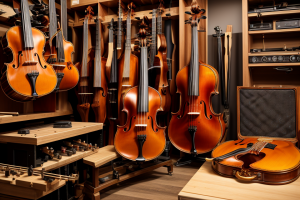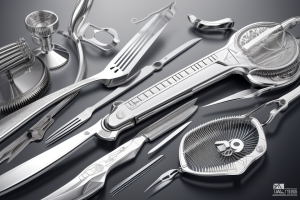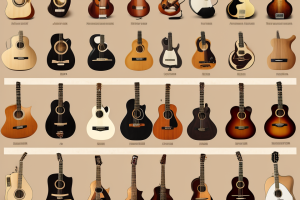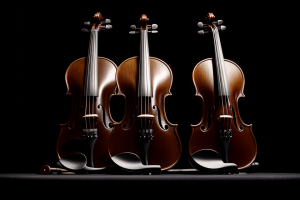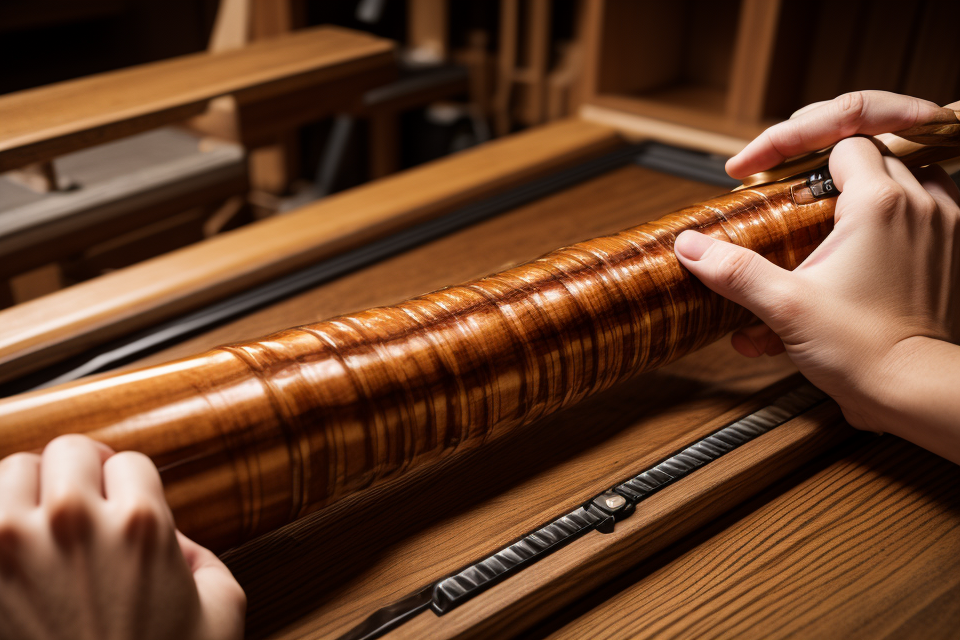
The world of musical instruments is a fascinating one, filled with a rich history, diverse cultures, and a wide array of instruments that bring music to life. But have you ever wondered who is responsible for creating these amazing tools of sound? In this article, we will explore the fascinating world of professionals who make musical instruments, delving into the art and science of instrument manufacturing. From the skilled craftsmen who handcraft each instrument to the engineers who use cutting-edge technology to design and create them, we will discover the many different professionals who bring music to our ears. So join us as we take a journey into the world of instrument making, and discover the passion, precision, and creativity that goes into creating the instruments we love.
What is Instrument Manufacturing?
Overview of the Process
Instrument manufacturing is the process of creating musical instruments that are used by musicians to produce sound. The process involves designing, selecting materials, cutting and shaping the body, assembling the parts, and finishing the instrument. Each step in the process requires precision and attention to detail to ensure that the instrument produces the desired sound quality.
The process of instrument manufacturing begins with the design of the instrument. This involves selecting the materials that will be used for the body, neck, and other parts of the instrument. Different materials produce different tonal qualities, and the manufacturer must choose the right materials to achieve the desired sound.
Once the materials have been selected, the manufacturer must cut and shape the body of the instrument. This is typically done using specialized tools and techniques to ensure that the body is symmetrical and the grain of the wood is straight. The neck of the instrument is also crafted during this stage, with the appropriate shape and size determined by the type of instrument being made.
After the body and neck have been crafted, the manufacturer must assemble the instrument. This involves attaching the neck to the body, adding the appropriate hardware such as tuning pegs and a bridge, and ensuring that all of the parts are properly aligned. The manufacturer must also ensure that the instrument is properly balanced and comfortable to play.
Finally, the instrument is finished. This may involve applying a protective coating or finish to the body, or adding any additional decorative elements. The finishing process is crucial to the overall sound quality of the instrument, as it can affect the way the wood vibrates and the way the sound is projected.
Overall, the process of instrument manufacturing is a complex and precise art that requires a deep understanding of materials, design, and sound. Only professionals with years of experience and expertise can create instruments that produce the rich, resonant sound that musicians desire.
Types of Musical Instruments Made
Musical instrument manufacturing involves the creation of a wide range of instruments that produce sound through various methods. Some of the most common types of musical instruments made include:
- Stringed Instruments: These include violins, cellos, guitars, and basses. They produce sound by vibrating strings that are plucked, strummed, or bowed.
- Woodwind Instruments: This category includes flutes, clarinets, saxophones, and others. They generate sound through the vibration of air columns produced by the player’s breath or a key system.
- Brass Instruments: Trumpets, trombones, French horns, and tubas are examples of brass instruments. They create sound by vibrating lips against a mouthpiece and using the acoustic properties of the instrument’s tubing.
- Percussion Instruments: This diverse group includes drums, cymbals, maracas, and xylophones. They produce sound through striking, shaking, or scraping their materials.
- Keyboard Instruments: Pianos and synthesizers are examples of keyboard instruments. They create sound through a keyboard that triggers a series of hammers or electronic signals.
- Electronic Instruments: Modern technology has led to the development of various electronic instruments, such as electronic drums, MIDI controllers, and digital audio workstations. These instruments use electronic circuits, sensors, and software to generate and manipulate sound.
Each type of instrument has its unique construction, materials, and playing techniques, making the world of musical instrument manufacturing both diverse and fascinating.
The History of Instrument Manufacturing
Early Instrument Makers
In the history of instrument manufacturing, the earliest instrument makers date back to ancient civilizations such as Greece, Rome, and Egypt. These early instrument makers crafted simple instruments using local materials such as wood, bone, and animal horns. Some of the earliest instruments included the Greek aulos, a woodwind instrument made from a reed and a hollow tube, and the Egyptian sistrum, a rattle-like instrument made from a hollow gourd or coconut shell.
One of the most significant contributions to the world of instrument manufacturing came from the European Middle Ages. During this time, instrument makers began to experiment with new materials and designs, resulting in the creation of more complex and sophisticated instruments. For example, the lute, a stringed instrument with a pear-shaped body and a neck with frets, became popular in Europe during the 14th and 15th centuries. Similarly, the crwth, a medieval stringed instrument played with a bow, was developed in Wales during the 16th century.
The 17th and 18th centuries saw a significant increase in the popularity of stringed instruments such as the violin, cello, and double bass. Italian instrument makers such as Stradivari and Amati were particularly renowned for their craftsmanship, and their instruments are still highly prized today. The French instrument maker, Hotteterre, was also well-known for his development of the clarinet and other wind instruments.
Despite the advances in instrument manufacturing over the centuries, it was not until the 19th century that the first modern factories for instrument manufacturing were established. The creation of these factories allowed for the mass production of instruments, making them more accessible to the general public. However, it was also during this time that many traditional instrument makers began to lose their livelihoods due to the rise of mass-produced instruments.
Today, instrument manufacturing continues to be a combination of art and science, with modern technologies and materials being used alongside traditional craftsmanship techniques. The field of instrument manufacturing remains highly competitive, with many skilled craftsmen and women dedicated to creating the highest quality instruments possible.
Evolution of Instrument Design
Throughout history, musical instruments have evolved in design and functionality. Early instruments were often simple and made from basic materials such as wood, bone, and shell. Over time, as societies became more advanced, so did the design and manufacturing of musical instruments.
In ancient civilizations, such as Egypt and Greece, instruments were often associated with religious ceremonies and were used to create music for the gods. The instruments of this time period were typically made from materials that were readily available and were often decorated with intricate designs.
As the centuries passed, instruments became more sophisticated. The development of the piano in the 18th century, for example, revolutionized the world of music. The piano allowed for greater dynamic range and expressiveness, and its design has changed little since its inception.
Other instruments, such as the violin, have also undergone significant changes in design over the years. The modern violin, for instance, is a far cry from its early ancestors, which were made from simple wooden frames and animal gut strings. Today’s violins are crafted with precision and care, using advanced materials and techniques to produce a rich, full sound.
The evolution of instrument design has been driven by a variety of factors, including technological advancements, cultural influences, and the needs and desires of musicians. As the world of music continues to evolve, it is likely that instrument design will continue to change and adapt to meet the demands of those who create and perform music.
The Science of Instrument Manufacturing
Materials Used in Instrument Making
Musical instruments are crafted using a variety of materials that must be carefully selected and combined to create the desired sound and overall quality of the instrument. Some of the most common materials used in instrument making include:
- Wood: Wood is one of the most traditional and widely used materials in instrument making. It is prized for its acoustic properties and is used to create a wide range of instruments, including guitars, violins, and cellos. Different types of wood are used for different parts of the instrument, such as the body, neck, and fretboard, each contributing to the overall sound and resonance of the instrument.
- Metals: Metals such as brass, copper, and steel are also commonly used in instrument making. Brass is often used to create trumpets, trombones, and French horns, while copper is used for the bells of cymbals and gongs. Steel is used to create strings for instruments such as guitars and violins.
- Synthetic materials: Synthetic materials such as plastic and resin are also used in instrument making. These materials are often used for the construction of electronic instruments and are chosen for their durability and resistance to wear and tear.
- Glass: Glass is used to create instruments such as glass harmonicas and wine glasses, which are used in specialized musical performances.
- Animal products: Some instruments, such as the violin bow, are made with animal products such as horsehair. These materials are chosen for their ability to provide the necessary tension and flexibility for the instrument to function properly.
The selection of materials for instrument making is a critical aspect of the process, as each material has its own unique properties that can affect the sound and overall quality of the instrument. Skilled instrument makers carefully select and combine materials to create instruments that are both functional and aesthetically pleasing.
Technology and Automation in Instrument Manufacturing
Advancements in Material Science
In recent years, advancements in material science have led to the development of new and innovative materials for instrument manufacturing. These materials offer unique properties that enable the creation of instruments with superior sound quality, durability, and precision. For example, carbon fiber is now commonly used in the construction of guitar necks and bodies, as it is lightweight, strong, and has excellent vibration characteristics. Similarly, advanced polymers are used in the production of violin bows, as they offer superior stability and responsiveness compared to traditional materials like horsehair.
Computer-Aided Design and Manufacturing
Computer-aided design (CAD) and computer-aided manufacturing (CAM) technologies have revolutionized the instrument manufacturing process. These technologies enable manufacturers to create highly accurate and precise instrument components using computer simulations and automated machining processes. This has led to significant improvements in the consistency and quality of instrument construction, as well as reduced production times and costs.
Robotics and Automation
Robotics and automation technologies are increasingly being used in instrument manufacturing to improve efficiency and precision. For example, robots are used to automate repetitive tasks such as sanding and polishing instrument surfaces, allowing manufacturers to achieve consistent finishes and reduce human error. Additionally, automated machining processes such as computer numerical control (CNC) milling and 3D printing are used to create complex instrument components with high levels of accuracy and precision.
Quality Control and Testing
Technology and automation also play a critical role in ensuring the quality and performance of musical instruments. Manufacturers use advanced testing equipment and software to evaluate the acoustic properties of instruments, such as their resonance, sustain, and timbre. This data is used to optimize instrument design and construction, ensuring that each instrument meets the highest standards of quality and performance.
In conclusion, technology and automation have played a significant role in the evolution of instrument manufacturing. Advancements in material science, computer-aided design and manufacturing, robotics and automation, and quality control and testing have enabled manufacturers to create instruments with superior sound quality, precision, and consistency. As technology continues to advance, it is likely that instrument manufacturing will become even more automated and efficient, allowing manufacturers to produce high-quality instruments at scale.
The Art of Instrument Manufacturing
Craftsmanship and Skill
The craftsmanship and skill involved in instrument manufacturing are critical factors that contribute to the quality and sound of the instrument. Each instrument is handcrafted with precision and care, and the craftsmen must possess a deep understanding of the materials, techniques, and traditions involved in the manufacturing process.
The following are some of the aspects of craftsmanship and skill involved in instrument manufacturing:
- Choice of materials: The choice of materials is crucial in instrument manufacturing, as each material has its unique properties that affect the sound and quality of the instrument. For example, the body of a guitar can be made from various types of wood, each with its distinct grain patterns, densities, and resonance characteristics. Skilled craftsmen carefully select the wood based on its grain pattern, density, and resonance, ensuring that the body will produce the desired tonal quality.
- Shaping and carving: Shaping and carving are critical aspects of instrument manufacturing, as they determine the instrument’s overall shape, size, and acoustic properties. Skilled craftsmen use specialized tools, such as chisels, gouges, and sandpaper, to shape and carve the wood, creating the desired contours and curves. They also pay close attention to the instrument’s internal structures, such as the soundhole, f-holes, and bridge, to ensure that they are correctly positioned and sized for optimal acoustic performance.
- Finishing and polishing: The finishing and polishing process is an essential aspect of instrument manufacturing, as it enhances the instrument’s appearance and protects it from damage. Skilled craftsmen use various techniques, such as sanding, staining, and varnishing, to achieve the desired finish and texture. They also pay close attention to the details, such as the fretboard, headstock, and tuning pegs, to ensure that they are correctly aligned and symmetrical.
- Attention to detail: Attention to detail is a critical aspect of instrument manufacturing, as even the slightest imperfection can affect the instrument’s sound and performance. Skilled craftsmen pay close attention to every aspect of the instrument, from the positioning of the frets to the shape of the soundhole, to ensure that they are perfectly aligned and symmetrical. They also use specialized tools, such as microscopes and calipers, to measure and inspect the instrument’s components, ensuring that they meet the highest standards of quality and craftsmanship.
In conclusion, the craftsmanship and skill involved in instrument manufacturing are essential factors that contribute to the quality and sound of the instrument. Skilled craftsmen possess a deep understanding of the materials, techniques, and traditions involved in the manufacturing process, and they use their expertise to create instruments that are both beautiful and functional. By paying close attention to every aspect of the instrument, from the choice of materials to the finishing and polishing process, skilled craftsmen ensure that each instrument is a work of art that inspires and delights musicians and audiences alike.
Personal Touch and Emotional Connection
Instrument manufacturing is not just about the technical aspects of creating an instrument; it is also about the personal touch and emotional connection that a craftsman brings to their work. Many instrument makers find that their work is a reflection of their personality and emotions, and they put a part of themselves into every instrument they create.
This personal touch can be seen in the attention to detail that instrument makers pay to every aspect of their craft. From selecting the right woods for the body of the instrument to hand-carving the f-holes, every step of the process is done with care and precision. This attention to detail is what gives each instrument its unique character and voice.
In addition to the technical aspects of instrument making, many craftsmen also believe that there is a spiritual element to their work. They feel a deep connection to the materials they use and the instruments they create, and they believe that this connection imbues the instrument with a special energy and life force.
This emotional connection to their work is what drives many instrument makers to create the best instruments possible. They are not just making objects, but works of art that will be played and enjoyed for generations to come. This personal touch and emotional connection is what sets instrument manufacturing apart from other forms of manufacturing and makes it a truly unique and special art form.
The Role of Education in Instrument Manufacturing
Formal Education and Training Programs
While many professionals in the field of instrument manufacturing have learned their craft through years of apprenticeship and hands-on experience, formal education and training programs also play a significant role in shaping the skills and knowledge of these experts. In this section, we will explore the various formal education and training programs available to those interested in pursuing a career in instrument manufacturing.
Bachelor’s Degree Programs
A growing number of institutions now offer bachelor’s degree programs specifically designed to equip students with the technical and artistic skills needed to excel in the field of instrument manufacturing. These programs typically combine coursework in areas such as materials science, engineering, and music theory with hands-on experience working in on-campus workshops or collaborating with local instrument makers.
Master’s Degree Programs
For those with more extensive experience or a strong background in a related field, master’s degree programs can provide advanced training in instrument manufacturing. These programs often focus on specialized areas such as instrument design, acoustics, or historical instrument construction, and may involve collaboration with researchers or scholars in related fields.
Vocational Training Programs
In addition to traditional academic programs, vocational training programs can offer a more streamlined approach to learning the craft of instrument manufacturing. These programs often involve intensive, short-term courses that focus on specific aspects of instrument construction, such as violin making or guitar building. Some programs may also offer apprenticeships or internships with established instrument makers, providing hands-on experience and real-world skills.
Online Education and Training
With the advent of online learning platforms, aspiring instrument makers can now access a wealth of educational resources from anywhere in the world. Online courses, webinars, and other digital resources offer flexible, self-paced learning opportunities for those looking to develop their skills in instrument manufacturing.
The Importance of Formal Education and Training
While there is no substitute for hands-on experience and apprenticeship in the world of instrument manufacturing, formal education and training programs can provide a solid foundation of knowledge and skills upon which to build a successful career. By equipping students with a deep understanding of materials science, engineering principles, and artistic techniques, these programs prepare graduates to approach instrument manufacturing with a comprehensive and interdisciplinary perspective. Additionally, formal education and training programs can help aspiring instrument makers network with industry professionals, access cutting-edge technologies and materials, and gain exposure to the latest trends and innovations in the field.
Apprenticeships and Hands-On Learning
In the world of instrument manufacturing, hands-on learning and apprenticeships play a crucial role in the education and training of professionals. Many skilled instrument makers choose to learn their craft through apprenticeships, which provide an opportunity to gain practical experience and develop technical skills under the guidance of a master craftsman.
During an apprenticeship, aspiring instrument makers work closely with experienced professionals, learning the intricacies of the craft through direct hands-on experience. This type of learning allows for the transfer of knowledge and skills that cannot be obtained through traditional classroom settings alone. Apprentices are often given the opportunity to work on real instruments, gaining experience in all aspects of the manufacturing process, from selecting the raw materials to the final assembly and finishing of the instrument.
In addition to apprenticeships, many instrument makers also participate in workshops and masterclasses, which provide opportunities for continued learning and skill development. These events often feature renowned experts in the field, who share their knowledge and techniques with attendees. By participating in these workshops and masterclasses, instrument makers can stay up-to-date with the latest advancements in their field and further develop their skills.
Overall, the hands-on approach to learning in instrument manufacturing provides a unique opportunity for aspiring professionals to gain the skills and knowledge necessary to create high-quality musical instruments. Through apprenticeships and continued learning opportunities, instrument makers can refine their craft and ensure the ongoing development of the industry as a whole.
The Future of Instrument Manufacturing
Emerging Technologies and Trends
In the world of instrument manufacturing, emerging technologies and trends are shaping the future of musical instrument creation. From 3D printing to artificial intelligence, these innovations are changing the way professionals design, craft, and produce musical instruments. Here’s a closer look at some of the most exciting emerging technologies and trends in the field.
3D Printing
One of the most significant advancements in instrument manufacturing is the widespread adoption of 3D printing technology. This innovative technique allows manufacturers to create complex shapes and designs quickly and efficiently, significantly reducing production time and costs.
Artificial Intelligence
Artificial intelligence (AI) is being utilized in various aspects of instrument manufacturing, from design to production. AI algorithms can help design more ergonomic and efficient instruments, analyze and optimize production processes, and even predict potential issues before they arise.
Sustainable Materials
As environmental concerns become increasingly important, many instrument manufacturers are turning to sustainable materials for their creations. Bamboo, carbon fiber, and recycled materials are just a few examples of eco-friendly alternatives that are gaining popularity in the industry.
Digital Instruments
Digital instruments, such as digital pianos and electric guitars, are becoming more popular among musicians. These instruments offer a wide range of tones and features, as well as the ability to connect to digital devices for recording and editing. As a result, many manufacturers are focusing on developing innovative digital instruments to meet the growing demand.
Customization and Personalization
In an effort to differentiate themselves from competitors and cater to the desires of today’s musicians, many instrument manufacturers are embracing customization and personalization. From engraving personal messages on instruments to offering a wide range of customizable options, such as body shapes and finishes, manufacturers are finding new ways to make their products stand out.
These emerging technologies and trends are not only changing the way musical instruments are manufactured but also providing new opportunities for professionals in the field. As these innovations continue to evolve, it will be exciting to see how they shape the future of instrument manufacturing.
Challenges and Opportunities in the Industry
Emerging Technologies and their Impact on the Industry
Emerging technologies are constantly changing the landscape of instrument manufacturing. One of the most significant impacts has been the rise of computer-aided design (CAD) and computer-aided manufacturing (CAM) systems. These technologies allow manufacturers to create more complex and precise instruments, while also reducing the time and cost associated with production. However, the adoption of these technologies also requires a significant investment in training and infrastructure, which can be a challenge for smaller manufacturers.
Sustainability and Environmental Concerns
Another challenge facing the industry is the need to be more environmentally sustainable. Consumers are increasingly concerned about the environmental impact of the products they purchase, and this includes musical instruments. Manufacturers must find ways to reduce their carbon footprint and use more sustainable materials, which can be difficult when balancing cost and performance. Additionally, the COVID-19 pandemic has disrupted supply chains and forced manufacturers to find new sources for materials, which can be a significant challenge.
Globalization and Competition
Globalization has also had a significant impact on the industry, as manufacturers now face competition from all over the world. This has led to a more competitive marketplace, with manufacturers constantly seeking ways to differentiate themselves and their products. To succeed in this environment, manufacturers must be able to adapt quickly to changing market conditions and be able to innovate in order to stay ahead of the competition.
Changing Consumer Preferences
Finally, changing consumer preferences are also presenting challenges and opportunities for instrument manufacturers. Consumers are increasingly interested in purchasing instruments that are not only high-quality but also aesthetically pleasing. This has led to a growing demand for custom instruments and special finishes, which can be challenging to produce at scale. Additionally, the rise of digital music technology has led to a decline in traditional musical instrument sales, as many consumers are choosing to produce and consume music digitally. Manufacturers must find ways to adapt to these changing preferences while still maintaining the quality and craftsmanship that is expected of them.
FAQs
1. What kind of profession makes musical instruments?
There are various professions involved in the manufacturing of musical instruments. Some of the most common professions include luthiers, who specialize in making stringed instruments such as violins, guitars, and cellos; piano technicians, who work on pianos; and brass and woodwind instrument makers, who create instruments such as trumpets, trombones, and clarinets. Other professionals involved in instrument manufacturing include sound engineers, who work on the electronic components of musical instruments, and instrument repairers, who fix and maintain instruments.
2. What kind of education is required to become an instrument maker?
The education required to become an instrument maker varies depending on the type of instrument being made. For example, luthiers typically have a background in woodworking and music, and may have completed formal training at a lutherie school or college program. Brass and woodwind instrument makers may have a background in engineering or music, and may have completed training at a technical school or university program. Sound engineers may have a background in electronics or music technology, and may have completed a degree program in audio engineering or a related field.
3. What skills are needed to be a successful instrument maker?
Successful instrument makers typically have a combination of technical skills, artistic ability, and a deep understanding of music. They must be able to work with their hands and have a good eye for detail, as well as a strong sense of craftsmanship. They must also have a good ear for music and be able to create instruments that produce the desired sound and tone. In addition, successful instrument makers must be able to work independently and be self-motivated, as well as being able to collaborate with other professionals in the industry.
4. What is the process of making a musical instrument?
The process of making a musical instrument can vary depending on the type of instrument being made. However, the general process typically involves designing and creating the instrument body and components, selecting and installing the necessary hardware and electronics, and adjusting and fine-tuning the instrument to ensure optimal sound quality. Luthiers, for example, may use traditional techniques such as hand carving and varnishing to create the body of a violin or cello, while brass and woodwind instrument makers may use CNC machines and other modern tools to create the components of their instruments.
5. How long does it take to make a musical instrument?
The amount of time it takes to make a musical instrument can vary depending on the complexity of the instrument and the skill of the maker. For example, a simple ukulele may take only a few hours to make, while a complex grand piano can take several months to create. Luthiers may spend months or even years creating a single instrument, as they carefully select and shape the wood, carve the body, and finish the instrument with layers of varnish. Brass and woodwind instrument makers may also spend several weeks or months crafting their instruments, depending on the intricacy of the design and the materials used.
